 W
WThe black-browed albatross, also known as the black-browed mollymawk, is a large seabird of the albatross family Diomedeidae; it is the most widespread and common member of its family.
 W
WThe striated caracara is a bird of prey of the family Falconidae. In the Falkland Islands, it is known as the Johnny rook, probably named after the Johnny penguin, one of its preys.
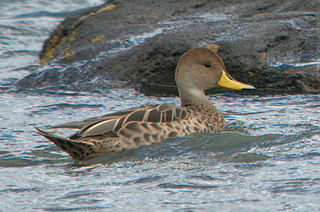 W
WThe Chilean pintail, also known as the golden peck duck or brown pintail, is a subspecies of the yellow-billed pintail, a duck in the dabbling duck subfamily Anatinae. Its local names are pato jergón grande, pato maicero and pato piquidorado in Spanish, and marreca-parda or marreca-danada in Portuguese.
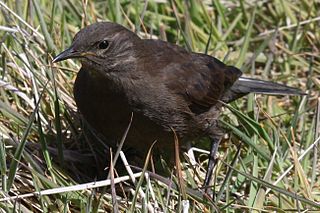 W
WThe blackish cinclodes is a passerine bird of the genus Cinclodes belonging to the ovenbird family Furnariidae. It is native to the southern tip of South America including the Falkland Islands where it is known as the tussac-bird or tussock-bird. It is often very tame and will approach humans closely.
 W
WThe correndera pipit is a species of bird in the family Motacillidae. It is found in Argentina, Bolivia, southern Brazil, Chile, the Falkland Islands, Paraguay, Peru, and Uruguay. Its natural habitats are temperate grassland, subtropical or tropical high-altitude grassland, and pastureland.
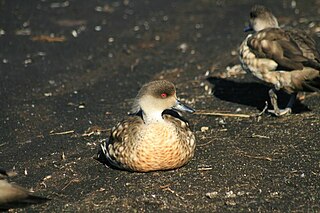 W
WThe Patagonian crested duck, also known as the southern crested duck, or the grey duck in the Falkland Islands, is the nominate of two subspecies of the crested duck.
 W
WThe flying steamer duck, also known as the flying steamer-duck or flying steamerduck, is a species of South American duck in the family Anatidae.
 W
WThe Falkland steamer duck is a steamer duck native to the Falkland Islands in the southern Atlantic Ocean. It is one of only two bird species endemic to the Falkland Islands, the other being Cobb's wren.
 W
WThe southern fulmar is a seabird of the Southern Hemisphere. Along with the northern fulmar, F. glacialis, it belongs to the fulmar genus Fulmarus in the family Procellariidae, the true petrels. It is also known as the Antarctic fulmar or silver-grey fulmar.
 W
WThe ruddy-headed goose is a large sheldgoose, which breeds in southernmost South America.
 W
WThe kelp goose, Chloephaga hybrida, is a member of the duck, goose and swan family Anatidae. It is in the shelduck subfamily Tadorninae. It can be found in the Southern part of South America - mainly in Patagonian Chile, Tierra del Fuego, and the Falkland Islands.
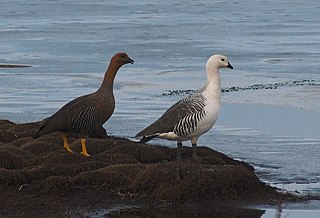 W
WThe upland goose or Magellan goose is a sheldgoose of the shelduck-sheldgoose subfamily of the Anatidae, the biological family that includes the ducks and most duck-like waterfowl such as the geese and swans. This bird is indigenous to the Falkland Islands which is located off of southern part of South America.
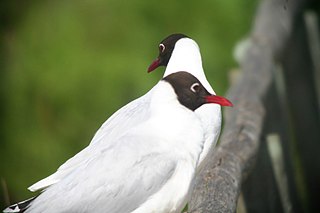 W
WThe brown-hooded gull is a species of gull found in Argentina, Brazil, Chile, the Falkland Islands, and Uruguay. Its specific epithet, maculipennis, means 'spotted wings'. It is a white bird with a brown head and red beak and feet.
 W
WThe dolphin gull, sometimes erroneously called the red-billed gull, is a gull native to southern Chile and Argentina, and the Falkland Islands. It is a coastal bird inhabiting rocky, muddy and sandy shores and is often found around seabird colonies. They have greyish feathers, and the feathers on their wings are a darker shade. Dolphin gulls have a varied diet, eating many things ranging from mussels to carrion.
 W
WThe cinereous harrier is a South American bird of prey of the harrier family. Its breeding range extends from the Tierra del Fuego through Argentina and Chile to Bolivia, Paraguay, Peru and southern Brasil; and across the Andes north to Colombia. The bird's population is declining but due to its large range is not considered vulnerable. The term cinereous, deriving from the Latin word for ashy, describes its colouration.
 W
WThe variable hawk is a polymorphic species of bird of prey in the family Accipitridae.
 W
WThe king penguin is the second largest species of penguin, smaller, but somewhat similar in appearance to the emperor penguin. There are two subspecies: A. p. patagonicus and A. p. halli; patagonicus is found in the South Atlantic and halli in the South Indian Ocean and at Macquarie Island.
 W
WThe long-tailed meadowlark is a passerine bird of southern South America and the Falkland Islands, belonging to the meadowlark genus Leistes in the icterid family that looks very similar to the related endangered species, the Pampas meadowlark.
 W
WThe blackish oystercatcher is a species of wading bird in the oystercatcher family Haematopodidae. It is found in Argentina, Chile, the Falkland Islands and Peru, and is a vagrant to Uruguay. The population is estimated at 15,000–80,000.
 W
WThe Magellanic penguin is a South American penguin, breeding in coastal Patagonia, including Argentina, Chile and the Falkland Islands, with some migrating to Brazil where they are occasionally seen as far north as Espirito Santo. It is the most numerous of the Spheniscus penguins. Its nearest relatives are the African penguin, the Humboldt penguin, and the Galápagos penguins. The Magellanic penguin was named after Portuguese explorer Ferdinand Magellan, who spotted the birds in 1520. The species is listed as Near Threatened by the IUCN.
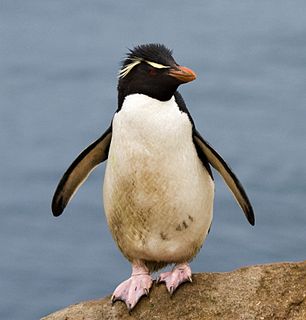 W
WThe southern rockhopper penguin group, are two subspecies of rockhopper penguin, that together are sometimes considered distinct from the northern rockhopper penguin. It occurs in subantarctic waters of the western Pacific and Indian Oceans, as well as around the southern coasts of South America.
 W
WThe blue petrel is a small seabird in the shearwater and petrel family, Procellariidae. This small petrel is the only member of the genus Halobaena, but is closely allied to the prions. It is distributed across the Southern Ocean but breeds at only six known sites, all close to the Antarctic Convergence zone.
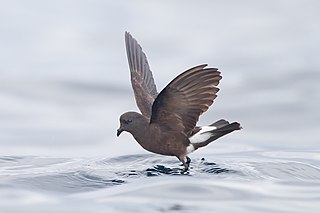 W
WWilson's storm petrel, also known as Wilson's petrel, is a small seabird of the austral storm petrel family Oceanitidae. It is one of the most abundant bird species in the world and has a circumpolar distribution mainly in the seas of the southern hemisphere but extending northwards during the summer of the northern hemisphere. The world population has been estimated to be more than 50 million pairs. The name commemorates the Scottish-American ornithologist Alexander Wilson. The genus name Oceanites refers to the mythical Oceanids, the three thousand daughters of Tethys. The species name is from Latin oceanus, "ocean".
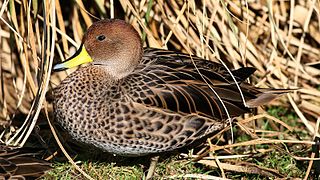 W
WThe yellow-billed pintail is a South American dabbling duck of the genus Anas with three described subspecies.
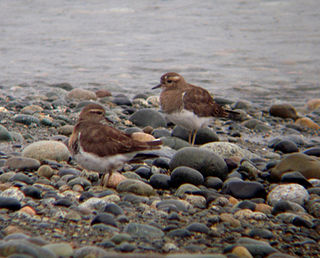 W
WThe rufous-chested plover or rufous-chested dotterel, is a monotypic species of bird measuring 19-22 centimeters in length and weighing between 71 and 94 grams It is part of the family Charadriidae. It breeds in southern parts of Argentina and Chile and on the Falkland Islands. Some birds migrate north in winter, reaching as far as Uruguay, southern Brazil and occasionally Peru. Its natural habitats are temperate grassland and sandy shores.
 W
WThe two-banded plover is a species of bird in the family Charadriidae. It breeds in Argentina, Chile and the Falkland Islands. Part of the population migrates north in winter with some birds reaching Uruguay and southern Brazil.
 W
WThe fairy prion is a small seabird with the standard prion plumage of black upperparts and white underneath with an "M" wing marking.
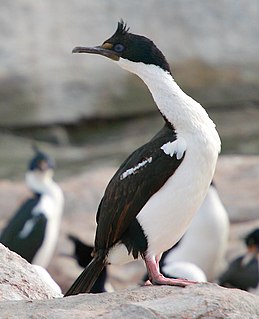 W
WThe imperial shag or imperial cormorant is a black and white cormorant native to southern South America, primarily in rocky coastal regions, but locally also at large inland lakes. Some taxonomic authorities, including the International Ornithologists' Union, place it in the genus Leucocarbo, others in the genus Phalacrocorax. It is also known as the blue-eyed shag, blue-eyed cormorant and by many other names, and is one of a larger group of cormorants called blue-eyed shags. The taxonomy is very complex, and several former subspecies are often considered separate species.
 W
WThe rock shag, also known as the Magellanic cormorant, is a marine cormorant found around the southernmost coasts of South America. Its breeding range is from around Valdivia, Chile, south to Cape Horn and Tierra del Fuego, and north to Punta Tombo in Argentina. In winter it is seen further north, with individuals reaching as far as Santiago, Chile on the west coast and Uruguay on the east. The birds also breed around the coasts of the Falkland Islands.
 W
WThe black-chinned siskin is a species of finch in the family Fringillidae. Found in Argentina, Chile and the Falkland Islands, its natural habitats are temperate forests and heavily degraded former forest.
 W
WThe brown skua, also known as the Antarctic skua, subantarctic skua, southern great skua, southern skua, or hākoakoa (Māori), is a large seabird that breeds in the subantarctic and Antarctic zones and moves further north when not breeding. Its taxonomy is highly complex and a matter of dispute, with some splitting it into two or three species: Falkland skua, Tristan skua, and subantarctic skua. To further confuse, it hybridizes with both the south polar and Chilean skuas, and the entire group has been considered to be a subspecies of the great skua, a species otherwise restricted to the Northern Hemisphere.
 W
WThe South American snipe or Magellan snipe is a small, stocky wader. Its taxonomic position is complicated, sometimes treated as a race of common snipe. The Andean population is now usually considered a distinct species, known as the puna snipe.
 W
WThe southern rough-winged swallow is a small swallow. It was first formally described as Hirundo ruficollis by French ornithologist Louis Vieillot in 1817 in his Nouveau Dictionnaire d'Histoire Naturelle.
 W
WThe black-necked swan is a swan that is the largest waterfowl native to South America.
 W
WThe coscoroba swan is a species of waterfowl endemic to southern South America. It is the smallest of the birds called “swans”, but still a large species of waterfowl. It belongs to the subfamily Anserinae in the family of ducks, swans, and geese, Anatidae. It is placed in the monotypic genus Coscoroba. The coscoroba swan is traditionally considered as an early branch from the common ancestor leading to true geese and swans, and recent genetic studies have associated a phylogenetic relationship between this species and the Cape Barren goose as sister groups.
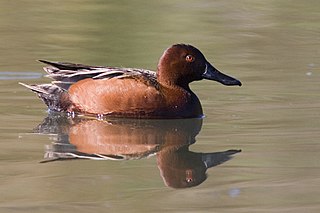 W
WThe cinnamon teal is a species of duck found in western North and South America. It is a small dabbling duck, with bright reddish plumage on the male and duller brown plumage on the female. It lives in marshes and ponds, and feeds mostly on plants.
 W
WThe silver teal or versicolor teal is a species of dabbling duck in the genus Spatula. It breeds in South America.
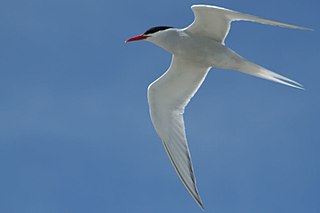 W
WThe South American tern is a species of tern found in coastal regions of southern South America, including the Falkland Islands, ranging north to Peru and Brazil. It is generally the most common tern in its range. The smaller, highly migratory common tern closely resembles it. The specific epithet refers to the "swallow-like" forked tail feathering.
 W
WThe austral thrush is a medium-sized thrush from southern South America. There are two subspecies, the Magellan thrush from south Argentina and south and central Chile, and the Falkland thrush from the Falkland Islands.
 W
WThe dark-faced ground tyrant is a small passerine bird belonging to the tyrant flycatcher family. It is a ground-dwelling bird that breeds in the southern Andes region and the Falkland Islands. It feeds on small invertebrates such as flies and moths.
 W
WCobb's wren is a fairly small (12-13.5 cm) wren which is endemic to the Falkland Islands. It was formerly classified as a subspecies of the house wren but is now commonly considered to be a separate species due to differences in plumage, voice, ecology and morphology.